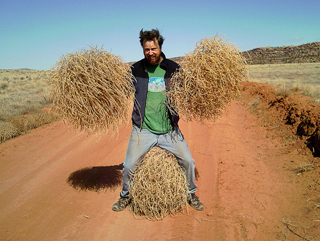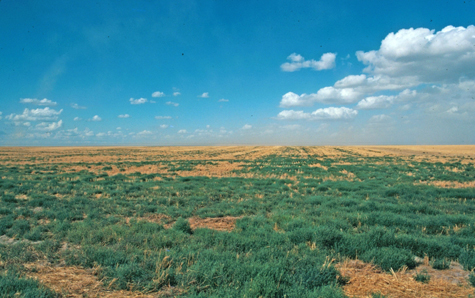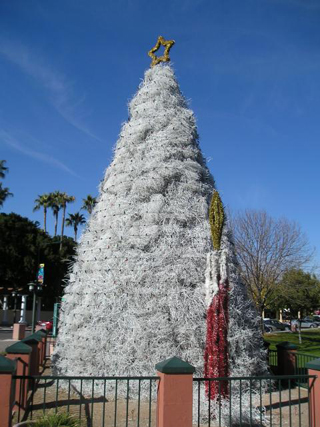Human Flower Project
Plants with Wheels
Noxious intruder, romantic emblem, or prom decoration? This Russian immigrant has become synonymous with America’s Old West.

Uranium collectors, “lonely but free…”
Photo: Rob Lee
By James H. Wandersee and Renee M. Clary
EarthScholars™ Research Group
“Bloom where you’re planted” is the motto of many species, but plants actually spread—and bloom—far beyond where they first grow using a wide variety of strategies, including wind power.
Some aeolian plants send their seeds off in gusts to seek their fortunes via cottony tufts (cattails) and parachutes (dandelions), while others employ gliders (climbing gourds) and helicopters (maple trees). Most wind-powered plants launch such “botanical aircraft” to disperse their seeds, but some plants actually make the scattering trip themselves. We’re talking about tumbleweeds.
Tumbleweeds are globe-like, senescent (aged, dried) plants whose stems, at maturity, separate from their root systems during windy weather. Before these bushes mature, most of them are green and bushy with tiny light pink flowers, turning gray and stiff when they are ready to tumble. Then they are pushed across the terrain by the prevailing winds, scattering thousands of seeds (up to 250,000 per plant!) across the landscape as they roll.

Tumbleweed (Russian thistle) infestation
Photo: Steve Dewey, Utah State University, Bugwood.org
The tumbleweed’s growth habit is most common in desert, foothill, and plains plants. Thus, in the U.S., tumbleweeds are most closely associated with the American West and the lonesome life of cowboys. In American literature and music, this plant has been used to represent, freedom, isolation, and the nomadic life. At some juncture in our lives, all of have wanted to be tumbleweeds!
Here are selected verses from a cowboy song known to many Americans (of a certain age):
See then tumbling down;
Pledging their love to the ground
Lonely but free I’ll be found;
Drifting along with a tumbling tumbleweed
I’ll keep rolling along;
Deep in my heart is a song
Here on the range I belong;
Drifting along with a tumbling tumbleweed.
—- Words & music by Bob Nolan, 1934, performed here by the Sons of the Pioneers.
While we may think such “plants with wheels” are purely American, our nation’s principal tumbleweed is a Russian immigrant, Salsola tragus. “Russian thistle,” accidentally imported into South Dakota in the late 1870s inside shipments of flaxseed, has become a widespread, noxious weed (even though it has sometimes served as an emergency livestock forage).
 An icon of the lonely vagabond life
An icon of the lonely vagabond life
Photo: 2bpblogspot
This annual plant breaks off at the base and forms a tumbleweed that disperses its seeds as it rolls over the ground. One 19th century North Dakota legislator proposed building a fence around the entire perimeter of the state to stop the tumbleweed invasion from South Dakota. But, alas, Salsola tragus proceeded to travel to 46 states.
Natural history writer David B. Williams notes, “This peregrinating plant also grows abundantly in Afghanistan, Argentina, Australia, Canada, Chile, China, Egypt, Greece, Hawaii, Hungary, Indonesia, Iran, Italy, Japan, Lebanon, Mexico, Morocco, New Zealand, Norway, Pakistan, Poland, South Africa, and Turkey.”
In some other tumbling seed-plant species, only the inflorescence (flower cluster) breaks off and tumbles, as in the garden plant “baby’s breath.” In Southeast Asia, Spinifex “tumble-grasses” do the same. A few species of plants have “tumble fruits.” There are even some spore-bearing plants (Selaginella lepidophylla, a lycopod) that dry and curl up into a ball for dispersal. Plants have indeed “invented the wheel” more than once!
However, the Russian thistle is the canonical tumbleweed rolling through Americans’ visual memories. Some enterprising prairie and desert dwellers have turned tumbleweed harvesting into a commercial venture. At a Kansas online store, you can purchase small, medium, or large tumbleweed (Russian thistle) specimens as Western décor for your home or high school prom. This merchant suggests that you might also want to buy tumbleweeds as props for your own western drama or independent video, (they can even be spray-painted gold for color-impact). Each plant is advertised as “wind-tested” before shipping and guaranteed to tumble. These entrepreneurs boast that their product is so fashionable, it’s even being sold on Rodeo Drive and in Aspen.
Robert Deitz of Business Week reports that tumbleweed order, “started to pour in from all the places where people love Hollywood Westerns: Alaska, Austria, Britain, Hong Kong, India. Japanese customers proved so eager that [the Kansas company] added a section to the Web site in Japanese. Movie and TV production companies in Britain, Finland, and the U.S. have ordered tumbleweed for props, too, including a $1,000 order for the children’s show Barney & Friends. A scientist from New Mexico wanted tumbleweed for research purposes. Many of the newfound customers use tumbleweed to decorate their homes, even in lieu of the traditional Christmas tree.”
 California “snowman” made from white spray-painted tumbleweeds
California “snowman” made from white spray-painted tumbleweeds
Photo: Jeff Johnston//Non Paratus
Tumbleweed business competitors have since staked their claims on the Internet, including a formidable one in Arizona. This enterprise features organically grown, naturally harvested, Southwest-cowboy-style tumbleweeds. The company proposes that its tumbleweeds be purchased for use in store displays, classrooms, arts and craft projects, and TV commercials, as well as for decorative applications at conferences, weddings, corporate events, fundraisers, and birthdays. It also specializes in monster-size tumbleweeds (natural composites of tumbleweeds)—although it cautions that car-sized tumbleweeds may cost hundreds of dollars to ship due to their volume.
For those who want to save shipping costs by growing their own, another Internet-based vendor sells packages of 500 tumbleweed seeds for ~$17—with 99,982 units in stock at this writing! There are perils to such gardening gambits. The sale of Russian thistle seed is illegal in some states, and 46 states classify Salsola tragus as a noxious weed. Russian thistle is actually on the federal plant police’s “most-wanted” list (cf. the 1974 Federal Noxious Weed Act).
In some places such as southern California, tumbleweeds are so dense that they carpet fences, clog canals, and damage water pumps. Yet in their place of origin (Mongolia and the Ural Mountains of Russia), they are not a problem: a mite eats the Russian thistle there and keeps it under control. Since the plants become herbicide resistant, this Asian mite is being proposed and tested as a possible solution to California’s tumbleweed problem.
 Chandler, Arizona’s tumbleweed tree
Chandler, Arizona’s tumbleweed tree
Photo: TempeHiker
For those plant entrepreneurs who have benefited financially from this common weed, it’s the plant equivalent of a “windfall profit.” Plus, at present, nobody is fretting about its sustainability or chanting, “Save the tumbleweed!”
The plant’s only redeeming physiological quality appears to be its value for use in phytoremediation of depleted uranium, a boon in arid environments that have been contaminated by weapons-testing; the tumbleweed actually removes this heavy metal from the soil and stores uranium in its own tissues. In south Nevada, at sites where many nuclear weapons were tested above ground, the tumbleweed was always the first plant to begin re-growing, even near “ground zero.”
You alone will have to decide if your living room chandelier needs tumbleweed-enhancement, or if you actually want three Russian thistles to create an unmeltable snowman, or if you crave hundreds to construct a tumbleweed holiday tree. Or maybe, a cowboy at heart, you prefer to let them tumble away in unfettered freedom.
Comments
Georgia—Are you aware of Fab Tree Hab? http://bigthink.com/mitchelljoachim/the-fab-tree-hab-finding-home-in-living-organisms
These look like folks you should know…
Thank you, always,
Julie


Fascinating essay Renee and James.
Two questions:
(1) To where does a uranium-filled tumbleweed tumble?
(2) Would the tumbleweed be a good material for natural building design (ex: the straw-bale house)?